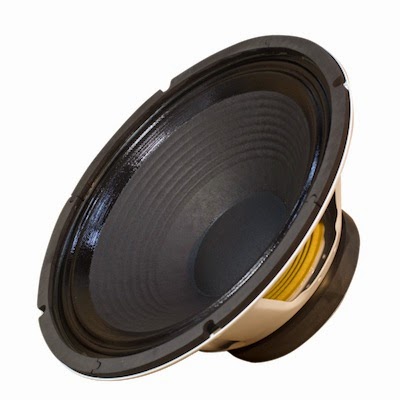
Most guitar players are blissfully unaware of the details of the speakers they’re playing through. Sure, they may know what size the speakers are and how many are in the cabinet, but other than that, they have no idea about how much of an effect the make of the speaker can have on the sound. Here’s a brief excerpt from The Ultimate Guitar Tone Handbook (written with Rich Tozzoli) that explains why they sound the way they do.
“Size
The size of a speaker has a great deal to do with the way it sounds. As you’ve probably noticed, an 8 inch sounds different than a 10 inch, which sounds different from a 12 inch, which sounds different from a 15 inch speaker. The reason is simple physics; the larger the cone, the more energy it takes to get it moving so the high end and the attack time won’t be as good as a speaker that’s smaller. Conversely, a smaller speaker has poorer low frequency response because it has less cone area to move air.
As a result, you’ll notice that an 8 inch speaker won’t have nearly as much bottom end as a 15 inch speaker, and the 15 with have quite the top end of a 10 inch speaker. That’s why 12 inch speakers are mostly used for guitar rigs; they’re a nice compromise between the two.
Number Of Speakers
That being said, the number of speakers in a cabinet can also have an affect on both the volume level and the low end. The more speakers that acoustically couple together, the more effective cone mass you have. As a result, a cabinet with two 12 inch speakers gives you 24 inches of cone mass while a a cabinet with four 10’s (like Fender’s original Bassman) gives you 40 inches. Of course, other factors like resonant frequency are involved, but this is a simple way to look at it.
Speaker Wattage
Contrary to what you might think, lower wattage speakers usually sound better than high-wattage ones. High-wattage speakers have heavier cones and surrounds that change the response of the speaker and therefore the tone. Because the cone is heavier, it slower to move when a signal is applied so the high frequency response isn’t as good as one with a thinner cone.
Other things that change in a higher wattage speaker is the diameter of the voice coil and the type of wire used for it are usually larger, which again changes the speaker’s response. A heavier magnet is also required because the voice coil is a bit heavier to move.
As a result, what you have is a speaker that’s harder to blow up, but also one that has a different frequency response and doesn’t break up as easily, which may be an important trait of your sound.
Magnet Structure
There are three different types of materials used in speaker magnets, Alnico, Ceramic, and Neodymium, with each material having a distinctly different effect on the tonal characteristics of the speaker.
- Alnico, an alloy of aluminum, nickel and cobalt, is the magnetic material used in the original speakers in all the vintage amps. It produces a classic tone that’s warmer and sweeter at lower volumes that many players feel reacts faster to the touch. Alnico was used for decades because of its strong magnetic field, but once the alloy became a bit pricey, many manufacturers opted for speakers with the less expensive ceramic magnets.
- Ceramic magnets were developed as an inexpensive alternative to Alnico and have the advantage of being more versatile with a wider range of tones. Speakers with ceramic magnets tend to weigh more, but generally handle more power and sound better at high volumes.
- Neodymium is the latest development in speaker magnet material. It’s not as expensive as Alnico but costs a bit more than ceramic magnet speakers. It has the advantages of both weighing about 50% less than other speakers and having stronger magnetic properties. Speakers made from neodymium respond to a player’s touch similar to Alnicos and have a well balanced frequency response.”
To read additional excerpts from The Ultimate Guitar Tone Handbook and my other books, go to the excerpts section of bobbyowsinski.com.

